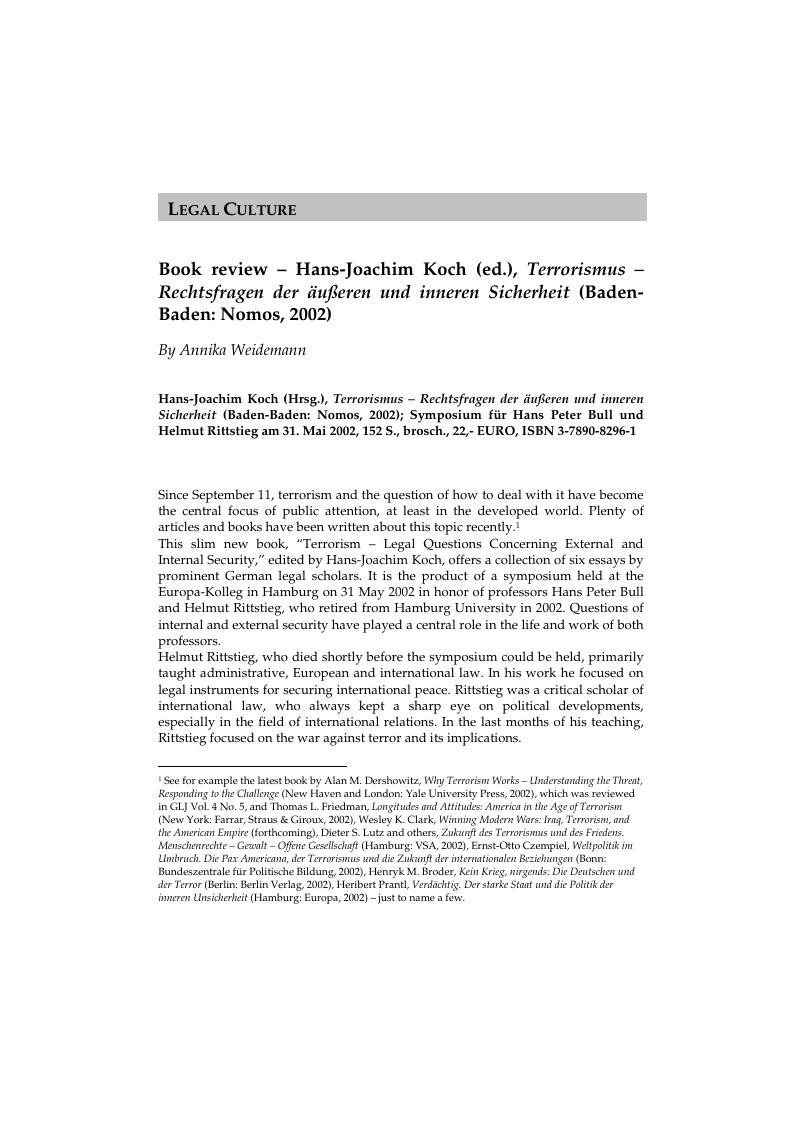No CrossRef data available.
Published online by Cambridge University Press: 06 March 2019

1 See for example the latest book by Alan M. Dershowitz, Why Terrorism Works – Understanding the Threat, Responding to the Challenge (New Haven and London: Yale University Press, 2002), which was reviewed in GLJ Vol. 4 No. 5, and Thomas L. Friedman, Longitudes and Attitudes: America in the Age of Terrorism (New York: Farrar, Straus & Giroux, 2002), Wesley K. Clark, Winning Modern Wars: Iraq, Terrorism, and the American Empire (forthcoming), Dieter S. Lutz and others, Zukunft des Terrorismus und des Friedens. Menschenrechte – Gewalt – Offene Gesellschaft (Hamburg: VSA, 2002), Ernst-Otto Czempiel, Weltpolitik im Umbruch. Die Pax Americana, der Terrorismus und die Zukunft der internationalen Beziehungen (Bonn: Bundeszentrale für Politische Bildung, 2002), Henryk M. Broder, Kein Krieg, nirgends: Die Deutschen und der Terror (Berlin: Berlin Verlag, 2002), Heribert Prantl, Verdächtig. Der starke Staat und die Politik der inneren Unsicherheit (Hamburg: Europa, 2002) – just to name a few.Google Scholar
2 See Lutz, 9-10, 16.Google Scholar
3 Lutz, 17.Google Scholar
4 Lutz, 10.Google Scholar
5 Francis Fukuyama, “The End of History?”, National Interest 18 (1989), 4.Google Scholar
6 This phrase does, of course, refer to Samuel Huntington, The Clash of Civilizations and the Remaking of World Order (New York: Touchstone, 1996, first paperback edition).Google Scholar
7 Lutz, 23, 25.Google Scholar
8 With the use of the words “Just Peace”, Lutz hints at the concept of “Just War.” See for this play on words also the book by Simon Chesterman, Just War or Just Peace: Humanitarian Intervention and International Law (Oxford: Oxford Monographs in International Law, 2001).Google Scholar
9 Oeter, 31.Google Scholar
10 See for the complete list Oeter, 35 et seq.Google Scholar
11 Article 2 para. 1 b) of the International Convention for the Suppression of the Financing of Terrorism.Google Scholar
12 Oeter, 40 et seq.Google Scholar
13 Oeter, 45 et seq.Google Scholar
14 Oeter, 50.Google Scholar
15 Oeter, 49.Google Scholar
16 See Bruha, Thomas/Bortfeld, Matthias, “Selbstverteidigung und Terrorismus. Voraussetzungen und Umfang erlaubter Selbstverteidigungsmaßnahmen nach den Anschlägen vom 11. September 2001“, Vereinte Nationen 49 (2001), 161.Google Scholar
17 Bruha, 79.Google Scholar
18 Bruha, 80.Google Scholar
19 Bruha, 81.Google Scholar
20 Bruha, 81.Google Scholar
21 Denninger, 84.Google Scholar
22 See Denninger, 84.Google Scholar
23 Denninger, 86 et seq.Google Scholar
24 Denninger, 87.Google Scholar
25 See Denninger, 89 et seq.Google Scholar
26 Denninger, 92.Google Scholar
27 See Gusy, 96.Google Scholar
28 The RAF (Red Army Faction) was a terrorist group with Marxist views that committed brutal attacks, including murder and hostage-taking, on high-ranking figures of German political and economic life.Google Scholar
29 Gusy, 108.Google Scholar
30 Gusy, 119.Google Scholar
31 Baldus, 121 et seq.Google Scholar
32 However, one needs to take into account that Baldus finished his research for the essay on 31 May 2002. For more current information see, for example, Europol's website at www.europol.eu.int.Google Scholar
33 See Europol Press Release, 20 December 2002, available at www.europol.eu.int.Google Scholar
34 Baldus, 136 et seq.Google Scholar